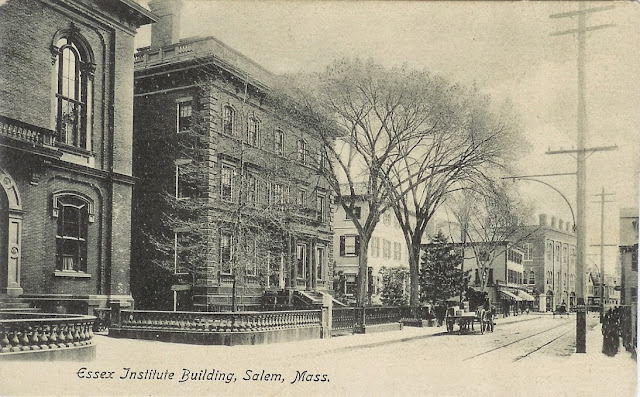Photo from article Horse and Carriage Days in Salem by Donna Seger
From The Genealogical Quarterly Magazine Volume 2 1901
Also appeared in Putnam's Monthly Historical Magazine and Magazine of New England History
Two years ago the editor of this magazine, in a very moderately worded article, called attention to the error perpetuated by the officials of The Essex Institute by the exhibition of a small structure claimed by them to be the original first meeting-house at Salem. Facts, easily accessible, taken from the town records,, were presented, showing not only how the error first originated, but also why the building so carefully preserved could not be what it was claimed to be. The Institute has distributed thousands of little booklets purporting to give a description of the "relic" and of the original meet1ng-house. It was even proposed to include this sham relic in the add1tion to the Institute building which is contemplated.
The exposure was met with unjust comments by the president of the institution and his supporters, which culminated in a personal attack upon the good faith of Hon. Abner Cheney Goodell (pictured above), one of the vice-presidents, whose name had been used, in an unauthorized manner,as a support to the claim that the Institute had preserved the original building. Mr. Goodell retaliated in an address read to the directors of the Institute, published later in pamphlet form, not only clearing himself from all suspicion of bad faith,but showing conclusively that he had been foremost in opposing the theory when it was first set up; that he never signed, and could not have signed, not being a member of the committee, the statement which has done service so many years, to substantiate the false character of the building. Moreover, he pointed out and made evident to any one who would follow the evidence presented, that Mr. Rantoul, now president of the society, was at the time the statement first saw light acting-editor of the Historical Collections of the Essex Institute, and consequently responsible for the misuse of Mr. Goodell's name. Various additional facts, showing the impossibility of the building so carefully preserved being the old meeting-house, were also presented, obtained largely from notes furnished Mr. Goodell by the author of the "Enquiry into the Authenticity of the First Meeting-house."
The result of the controversy was the appointment by the directors of the Institute, of a committee to look into the question. Although two years have passed no report has been made, but it is said, upon excellent authority, that Mr. Sidney Perley (Pictured), who was employed by the committee to search the records for evidence, has completed his task and has arrived at a conclusion coinciding with that advanced in this magazine two years ago, that is, that the building preserved by the Institute is not in any way connected with the first meeting-house at Salem.
In this number we present two views, one representing the building as it now stands, and which has passed all these years for the original meeting-house partially restored. Opposite is presented a view of the building as it was when first discovered and before the restoration. It is to be hoped that the Institute will publish the finding of the special committee. It may be said in passing that the suggestion that this building is the first meeting-house of the Friends is quite as largely theory as the former and now exploded claim. The investigations made by the writer two years ago have convinced him that not only was the first meeting-house erected at a date much earlier than claimed for this substitution, but that it was all that one would expect a place of worship of a so intensely religious people to be. As to its use for secular purposes there can be little doubt, nor that it was roomy, nearly square, and not unlike in shape the types which were persisted in for nearly a century. Against its walls were built shops; it was the rallying place of the watch; it was the centre of the life of the settlement; and it was in every respect worthy of a town which for a time hoped to be the seat of government.
By James H. Emmerton the building was then standing on the land of David Nichols now Proctor Street, off of Boston Street. The original of this sketch went to the family of Mr. John Robinson, of Salem, but a duplicate, the gift of Dr. Emmerton, has been in the possession of the Institute since 1869.
 |
The "cow-shed" As It Now Appears. From a photograph by Frank Cousins. |










No comments:
Post a Comment